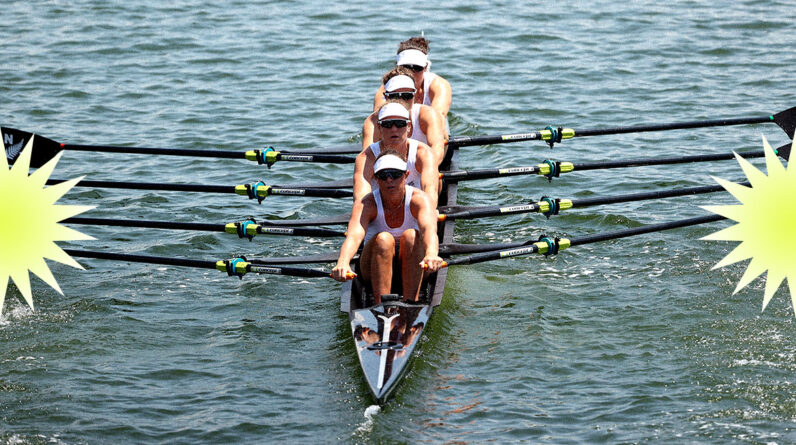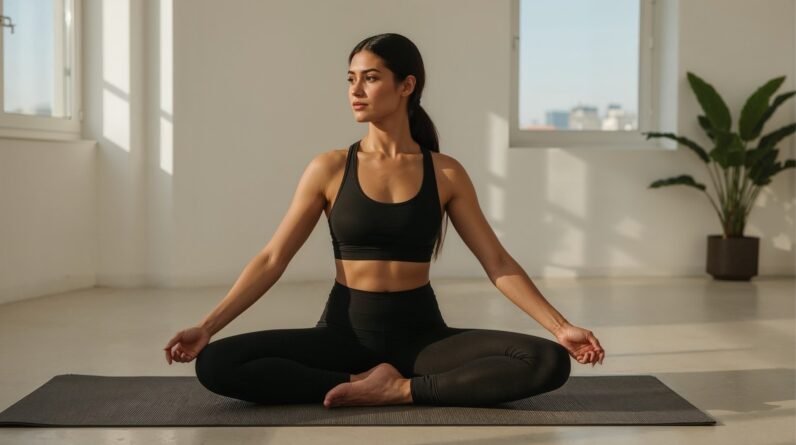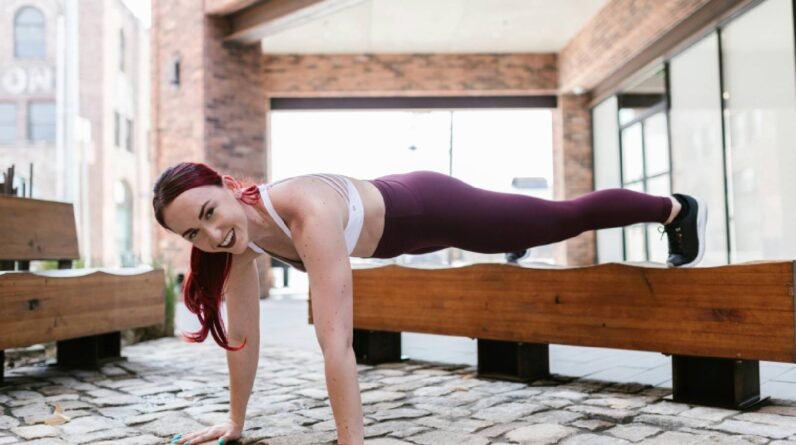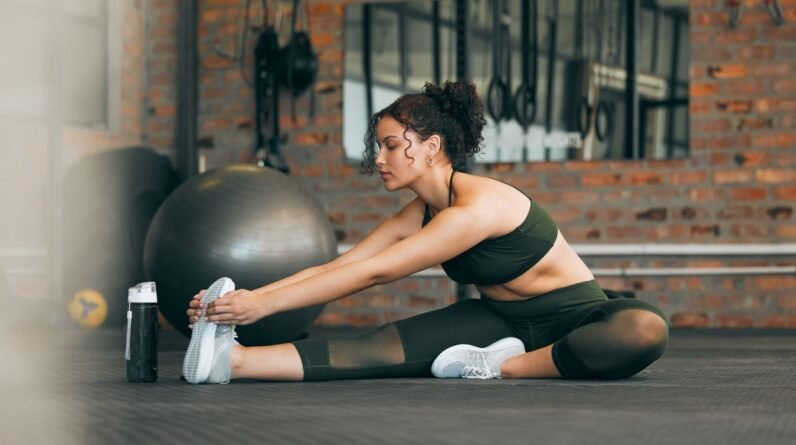
Olympic rowing will no doubt be a buzzy sport at the Paris 2024 Olympic Games, where athletes plan to compete across a distance of 2,000 meters in teams of two, four, or eight.
If the excitement around this ancient sport has you considering dusting off the rowing machine in your basement or checking one out at your gym, it’s not a bad idea: There are many benefits of a rowing machine—and it’s not just about strong arms.
Here’s what to know about the benefits of a rowing machine you’ll love, how to use one correctly, and tips for beginners.
How to correctly use a rowing machine
First, let’s get the rowing technique down. When you see someone using a rowing machine, it may seem like they’re performing one fluid movement—but it’s actually a sequence of movements that are done in a specific order.
Here are step-by-step instructions for how to use a rowing machine, according to Sarah Pelc Graca, CPT, certified personal trainer and owner and head coach at Strong with Sarah Health Coaching.
- Adjust the foot straps: Sit on the rowing machine and place your feet securely in the foot straps. The straps should be snug (but not too tight) around the balls of your feet, allowing both feet to move freely as you row.
- Position yourself on the seat: Sit tall on the seat with your knees bent and feet resting against the footplate. Your shins should be vertical and your heels should be slightly raised.
- Grab the handle: Reach forward and grab the handle with an overhand grip, keeping your arms straight—but not locked at the elbows—and your shoulders relaxed.
- Perform the catch: This is the starting position of the rowing stroke. Your arms should be extended and your back straight, but you should be slightly leaning forward at the hips. Keep your knees bent and your shins vertical.
- Perform the drive: Initiate the rowing stroke by pushing through your legs, driving them down, and extending your knees. Keep your core engaged and lean back slightly once your legs straighten.
- Perform the pull: Once your legs are fully extended, continue the motion by pulling the handle toward your lower chest near the bottom of your ribs, keeping your elbows close to your body. As you pull, focus on engaging your back muscles, particularly your latissimus dorsi (aka the lats, the large muscles found right below your shoulder blades and across your back).
- Perform the finish: At the end of the stroke, your legs should be fully extended, and the handle should be pulled to your lower chest, just below your sternum. Your shoulders should be relaxed and your wrists flat.
- Recover: Reverse the motion by extending your arms, leaning forward at the hips, and bending your knees to slide back to the starting position. Keep your movements smooth and controlled, avoiding jerky motions.
The benefits of a rowing machine you’ll love
1. It builds strength in your legs and back
When you think “rowing,” bulked-up biceps may come to mind—but it’s actually a common misconception that rowing mainly targets your arm muscles.
“While it does have benefits to the arms, the main muscles used in rowing are your legs and back,” says Kate Knifton, a member of Team USA Rowing for the 2024 Paris Olympics and trainer for Myrow. “The rowing stroke may look like a ‘pulling’ motion using the arms, but instead it is a ‘pushing’ motion using the quadriceps, hamstrings, and calves.”
Plus, your back muscles (especially the lats and rhomboids) are strengthened as you bring the handle toward your body. Throughout the entire stroke, your core muscles engage to protect your lower back.
The benefits of a rowing machine also extend to your overall posture, helping you to straighten out your back, which is especially helpful after hours of working at a desk.
“Rowing requires proper posture and technique, which can help to strengthen both the back and core muscles while improving overall posture,” Pelc Graca says. “This can alleviate discomfort associated with poor posture and reduce the risk of developing postural imbalances, especially for people who sit at a desk all day at work.”
2. It’s a low-impact cardio workout
Rowing is a great way to get your heart rate up, while being lower impact than many other forms of cardio like running or jumping. (Lean more about rowing versus running here!)
“It is the perfect choice for people recovering from certain injuries or joint issues,” Knifton says. “Rowing is also one of the only sports that provides a full-body workout. This use of muscles enhances cardiovascular fitness and endurance.”
You can even save time by combining your cardio and strength exercises with a rowing machine workout.
“Rowing with proper form recruits approximately 85 percent of the muscles in your body when completing one full stroke, while at the same time steadily increasing your heart rate for an efficient workout,” Pelc Graca says.
3. It’s customizable
When you use a rowing machine, you’re not stuck with one type of workout or level of difficulty.
“Rowing machines typically offer adjustable resistance levels, allowing users to tailor their workouts to their fitness level and goals,” Pelc Graca says. “Plus, rowing workouts can vary in intensity and duration, providing flexibility for individual preferences and needs.”
Many fitness services like MyRow or Peloton also offer rowing classes that you can digitally stream. These workouts teach you how to row properly and challenge you through different routines—perfect for if you tend to get bored quickly with your workouts.
4. It’s convenient and accessible
Although you do need equipment for rowing, these machines are available in many gyms and fitness centers. You can also choose to invest in one for your home gym—they typically run anywhere from $300 to $3,000. (These foldable rowing machines don’t take up much space at all!)
“This makes it a convenient option for incorporating regular exercise into your routine,” Pelc Graca says. “Plus, because rowing tends to be a bit less popular than running at the moment, there is never usually a wait for the rowing machines at the gym.”
Because rowing puts less stress and impact on your joints, it’s also an accessible option for people of all fitness levels. That includes those who have joint issues or who are just starting to exercise again after an injury.
“Rowing with proper form recruits approximately 85 percent of the muscles in your body when completing one full stroke, while at the same time steadily increasing your heart rate for an efficient workout.” —Sarah Pelc Graca, CPT
The muscles you work when rowing
Rowing is an efficient way to fit in a full-body workout that engages muscles across your entire body. Here’s a breakdown of the various muscles targeted during a rowing machine workout, according to Pelc Graca.
- Legs (quadriceps, hamstrings, and calves): A powerful leg push drives the rowing stroke. “As you push off the footplate, your quadriceps [front thigh muscles], hamstrings [back thigh muscles], and calf muscles engage to extend your knees and drive your body backward,” Pelc Graca says.
- Glutes: Your gluteus maximus, the largest muscle in your butt, plays a key role in the leg drive phase of rowing. This is the muscle that helps to extend your hips and provide significant power during that initial push-off.
- Core (abdominals and lower back): “Rowing requires your core stabilization muscles to engage, so that you can maintain proper posture and transfer power from your legs to the upper body,” Pelc Graca says. The rectus abdominis (front abs), obliques (side abs), and erector spinae (lower back muscles) all work together to support your spine and pelvis throughout the entire rowing stroke.
- Back (latissimus dorsi, trapezius, and rhomboids): When you “pull” in a rowing stroke, that movement primarily targets the back muscles. Your lats are the main muscles responsible for pulling the handlebars toward your body. Plus, the trapezius and rhomboid muscles in your upper back help stabilize your shoulder blades and assist with that pulling motion.
- Arms (biceps and triceps) and shoulders (deltoids and rotator cuff muscles): Your arms and shoulder muscles team up during the final phase of the rowing stroke as your arms flex and you pull the handles or oars toward your lower chest.
Tips for beginners trying rowing
1. Consider rowing as movements in a certain order
Remember, rowing doesn’t involve just one movement, but rather a series of motions that come together.
A simple way to think about the correct form for a rowing stroke is in this sequence, according to Pelc Graca: legs, core, and arms during the power phase—and arms, core, legs during the recovery phase.
2. Take your time during the recovery phase
Allow the handle to return smoothly as you bend your knees and lean forward at the hips during recovery. Rowing is about powering up your legs, not speed.
“Neglecting the recovery phase of the rowing stroke by rushing back to the starting position can disrupt your rhythm and breathing, while decreasing the effectiveness of your workout,” Pelc Graca says.
3. Adjust the machine to your liking
With rowing, one size does not fit all. One of the benefits of a rowing machine is that there are customizable features you can use to make sure it matches your needs.
“Start by adjusting the machine to be most comfortable to you,” Knifton says. “Adjust the straps on your feet so they fit comfortably over the widest part of your feet.”
Safety precautions to keep in mind when rowing
When you’re working out on a rowing machine, keep these tips in mind to stay safe and injury-free.
1. Avoid pulling too hard with your arms
Rowing shouldn’t rely solely on your arms. Because it’s primarily a leg-driven exercise, your focus should be on initiating the movement with a powerful leg drive.
“One of the most common mistakes is relying too much on the arms to pull the handle, neglecting the legs and back,” Pelc Graca says. “This can lead to fatigue and strain on the arms and shoulders, as well as low back pain.”
2. Keep your back straight
Focus on maintaining a straight back throughout your entire stroke. Your core should be engaged and your shoulders pulled back.
“Allowing the back to round or hunch over during the rowing stroke can put undue stress on the spine and increase the risk of injury,” Pelc Graca says.
3. Don’t reach too far
Stretching too far forward at the beginning of the rowing stroke, or the catch, can strain your lower back and hamstrings.
“Instead, aim to maintain a comfortable reach forward without overextending,” Pelc Graca says. “Your shins should be vertical at the catch, with your knees bent and your back slightly leaning forward at the hips.”
4. Watch your foot placement
If you put your feet too high or low on the footplate, it can shift your rowing technique and cause discomfort or injury.
“Position your feet securely in the foot straps, with the balls of your feet resting against the footplate,” Pelc Graca says. “Your heels should be slightly raised before beginning and your feet should be flat throughout the rest of the stroke.”
“Rowing machines typically offer adjustable resistance levels, allowing users to tailor their workouts to their fitness level and goals. Plus, rowing workouts can vary in intensity and duration, providing flexibility for individual preferences and needs.” —Sarah Pelc Graca, CPT
FAQ
How high should you set the resistance?
Start slow with resistance: A common rowing mistake beginners make is setting the resistance too high. If the machine’s resistance dial goes from one to 10, stick to a number between three and five, per the Hospital for Special Surgery (HHS).
This will most closely resemble rowing on water—even competitive rowers stick to this middle range for resistance. Going too high for too long will increase the load on your lower back.
When should you use a rowing machine?
If you’re just starting out, aim for five to 10 minutes of rowing. Work up to 30 minutes or longer, per the HHS.
If you go longer than 30 minutes, break your workout into different chunks. For instance, row for 20 minutes, then walk and stretch for five minutes before continuing your rowing for another 20 minutes.
Start by rowing two to three times per week. Eventually, you can increase your frequency to four to five workouts weekly. To give your body time to recover, avoid rowing every single day.
Can you use a rowing machine if you’re injured or recovering from surgery?
One of the major benefits of a rowing machine is that it can be adjusted to your needs, so it caters to quite a variety of people, per Northwell Health. This includes those who are recovering from surgery or injury. (It can even be ideal for those with underlying conditions, like arthritis, who can’t use their body weight through a full range of motion.)
Here’s just one example of a modification you can make: If you have an injury on your ankle or knee, place your injured leg on a slider next to the machine on the floor. This will allow you to gently shift your injured leg back and forth when using the machine, while you use your uninjured leg as you normally would.
If you use a wheelchair, you can also detach the rowing machine’s seat and use the handle while remaining in the wheelchair.






